How to Fill a Bike Tire with an Air Compressor

Riding a bike is a great way to stay active and enjoy the outdoors, but what happens when your bike tire goes flat? Filling a bike tire with an air compressor is a quick and convenient solution that can have you back on the road in no time. By following a few simple steps, you can ensure that your bike tire is properly filled and ready for your next ride.
The first step in filling a bike tire with an air compressor is to locate the valve stem on the tire. This is the small, cylindrical piece that allows air to enter and exit the tire. Most bike tires use a Schrader valve, which is similar to the valves found on car tires. If your bike tire has a different type of valve, such as a Presta valve, you may need an adapter to use an air compressor.
Once you have located the valve stem, you will need to remove the cap to expose the valve. This will allow air to flow freely into the tire. It is important to keep track of the cap while filling the tire, as losing it can result in dirt and debris entering the valve and causing damage.
With the valve cap removed, you can now connect the air compressor to the valve stem. Most air compressors come with a nozzle that can be easily attached. Ensure that the nozzle is securely connected to the valve stem to prevent any air from escaping during the filling process.
Filling a Bike Tire with an Air Compressor
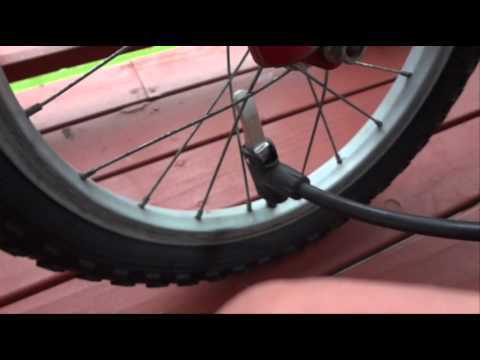
Step 1: Prepare the Bike Tire
Before filling a bike tire with an air compressor, it’s important to first prepare the tire. Start by checking the current pressure of the tire using a tire pressure gauge. This will help you determine how much air the tire needs. If the pressure is too low, you will need to add more air.
Next, locate the valve stem on the bike tire. This is where you will attach the air compressor nozzle. Make sure the valve stem is clean and free of any debris or obstructions. This will ensure a secure and efficient connection between the tire and the air compressor.
Step 2: Attach the Air Compressor Nozzle
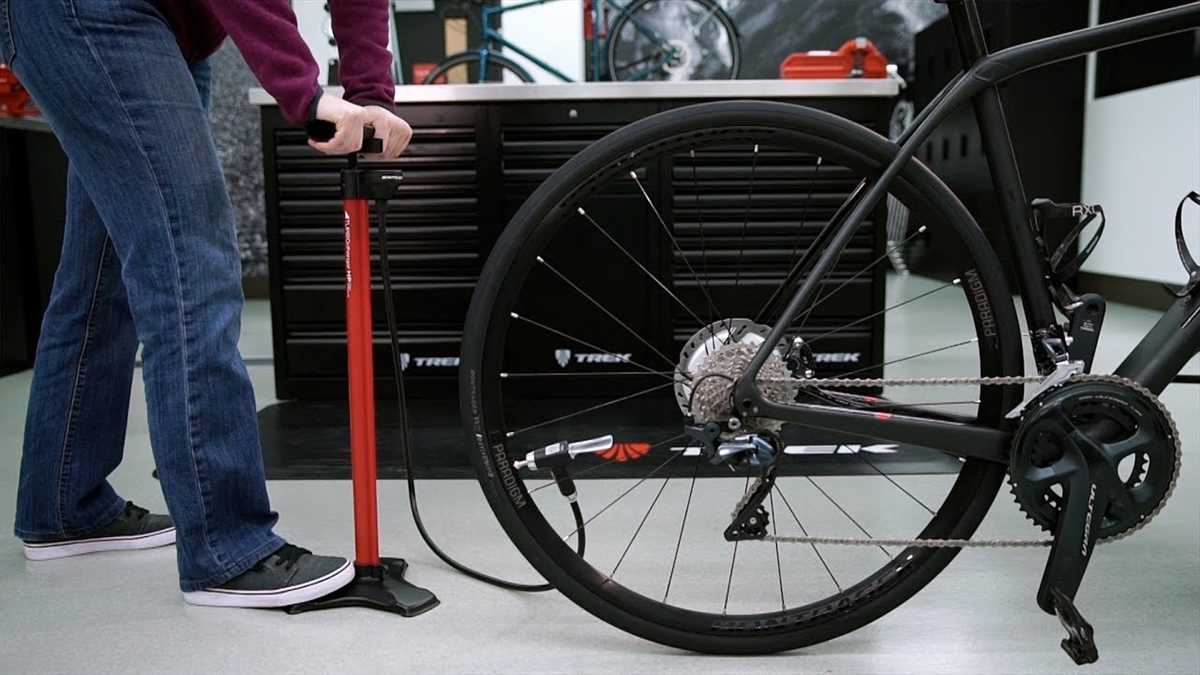
Once the bike tire is prepared, it’s time to attach the air compressor nozzle. Take the nozzle and align it with the valve stem. Press the nozzle firmly onto the valve stem to create a tight seal. Make sure the nozzle is properly aligned and centered to prevent any air leakage.
Before starting the air compressor, it’s important to ensure that the pressure settings are correct. Most bike tires require a pressure range of 30-50 psi (pounds per square inch). Adjust the pressure settings on the air compressor accordingly.
Step 3: Fill the Bike Tire
With the nozzle properly attached and the pressure settings adjusted, it’s time to start filling the bike tire. Turn on the air compressor and allow it to build up pressure. Once the pressure is steady, begin filling the tire by squeezing the air compressor handle or pressing the appropriate button.
While filling the tire, keep an eye on the pressure gauge to ensure you reach the desired pressure. Avoid overfilling the tire, as this can lead to a blowout. Once the tire is properly filled, carefully remove the air compressor nozzle from the valve stem, making sure not to release any excess air.
After filling the bike tire, it’s a good idea to double-check the pressure using a tire gauge. Make any necessary adjustments to achieve the optimal tire pressure for safe and efficient bike riding.
Conclusion
Filling a bike tire with an air compressor is a simple and convenient process. By following the steps mentioned above and taking the necessary precautions, you can ensure that your bike tire is properly inflated and ready for your next ride.
Gather the necessary materials
Air Compressor
An air compressor is a device that pressurizes air and provides a steady flow of compressed air. It is an essential tool for filling bike tires quickly and efficiently.
Tire Pressure Gauge
A tire pressure gauge is used to measure the air pressure in bike tires. It is important to have an accurate tire pressure gauge to ensure the correct inflation of the tires.
Valve Adapter
A valve adapter is needed to connect the bike tire valve to the air compressor. There are different types of valve adapters available depending on the type of valve on the bike tire.
Bike Pump
A bike pump can also be used to fill bike tires, but an air compressor provides a faster and easier way to inflate the tires.
Water Spray Bottle
A water spray bottle can be used to moisten the bike tire before attaching the valve adapter. This helps to create a better seal between the valve adapter and the tire valve.
Safety Glasses
Wearing safety glasses is important when using an air compressor to fill bike tires. They protect the eyes from any debris or particles that may be released during the inflation process.
Check the tire pressure
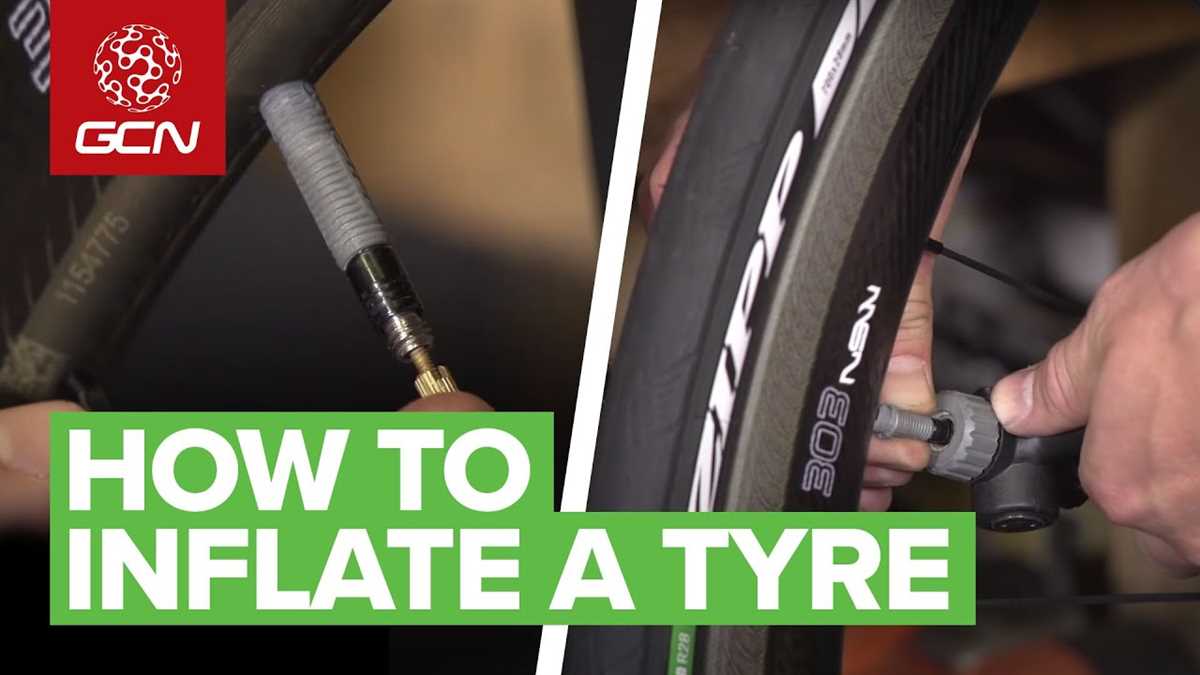
To ensure your bike tire is properly inflated, it is essential to regularly check the tire pressure. This is an important maintenance task that will help optimize your riding experience and improve your bike’s performance.
Start by locating the valve stem on the bike tire. The valve stem is a small metal or rubber protrusion that allows air to be pumped into the tire. It is usually located on the inner side of the tire, close to the rim. Once you have located the valve stem, you can proceed to check the tire pressure.
Use a tire pressure gauge to measure the air pressure in the tire. Insert the tire pressure gauge onto the valve stem and press firmly until you hear a small hiss of air being released. The tire pressure gauge will provide a reading of the current air pressure in the tire.
Compare the measured tire pressure with the recommended tire pressure. The recommended tire pressure can usually be found imprinted on the side of the bike tire or in the owner’s manual. It is important to inflate the tire to the correct pressure to ensure optimal performance and safety.
Locate the valve stem
To fill a bike tire with an air compressor, the first step is to locate the valve stem. The valve stem is the part of the tire that allows air to be pumped in or released. It is typically found on the inner side of the tire, near the rim. The valve stem is usually made of rubber and has a small cap on top to protect it from dirt and debris. Look for a small metal or plastic knob on the valve stem, which is used to open and close the valve.
Inflate the tire carefully to avoid overinflating. This can cause the tire to burst or the inner tube to be damaged. Check the recommended tire pressure for your bike and adjust the air compressor accordingly. It is a good idea to start with a lower pressure and gradually increase it if needed. Attach the nozzle of the air compressor to the valve stem and make sure it is securely attached. Hold the nozzle in place while the air is being pumped into the tire.
Monitor the pressure as you inflate the tire. Keep an eye on the pressure gauge of the air compressor or use a separate tire pressure gauge to check the pressure. Stop inflating the tire when it reaches the recommended pressure. If the pressure is too low, add more air. If it is too high, release some air by pressing on the valve stem or using a valve stem tool. Once the tire is properly inflated, remove the nozzle from the valve stem and replace the cap.
Remove the valve cap
Before you can begin filling your bike tire with an air compressor, you first need to remove the valve cap. The valve cap is a small plastic or metal cap that covers the valve stem. It is important to remove the valve cap to allow for air to properly flow into the tire.
Step 1: Locate the valve stem on your bike tire. It is usually located on the inner side of the wheel, near the hub.
Step 2: Use your fingers to unscrew the valve cap counterclockwise. Be careful not to apply too much pressure or force, as this can cause damage to the valve stem.
Step 3: Once the valve cap is removed, set it aside in a safe place. It is important not to lose the valve cap, as it helps to keep dirt and debris out of the valve stem.
Note: If your valve cap is attached to a valve extension, you may need to unscrew the extension first before removing the valve cap.
Connect the air compressor
Before filling your bike tire with an air compressor, you’ll need to connect the compressor to the tire valve. Start by finding the valve on your tire, which is usually located on the inner side near the rim. The valve is typically a small, cylindrical metal piece that protrudes from the tire.
Next, remove the cap from the valve by unscrewing it. This will expose the inner part of the valve, which is necessary for connecting the air compressor. Keep the valve cap in a safe place so you don’t lose it.
Now, take the air hose of the compressor and locate the quick-connect coupler. The quick-connect coupler is usually found at the end of the hose and is designed to easily attach and detach to different devices. Insert the quick-connect coupler onto the valve stem and push it firmly until you hear a click or feel it securely attached.
Once the air compressor is connected to the tire valve, ensure that the connection is tight and secure. You can gently pull on the hose to make sure it won’t disconnect during the inflation process. If the connection feels loose, adjust it until it is firmly attached.
Set the desired pressure
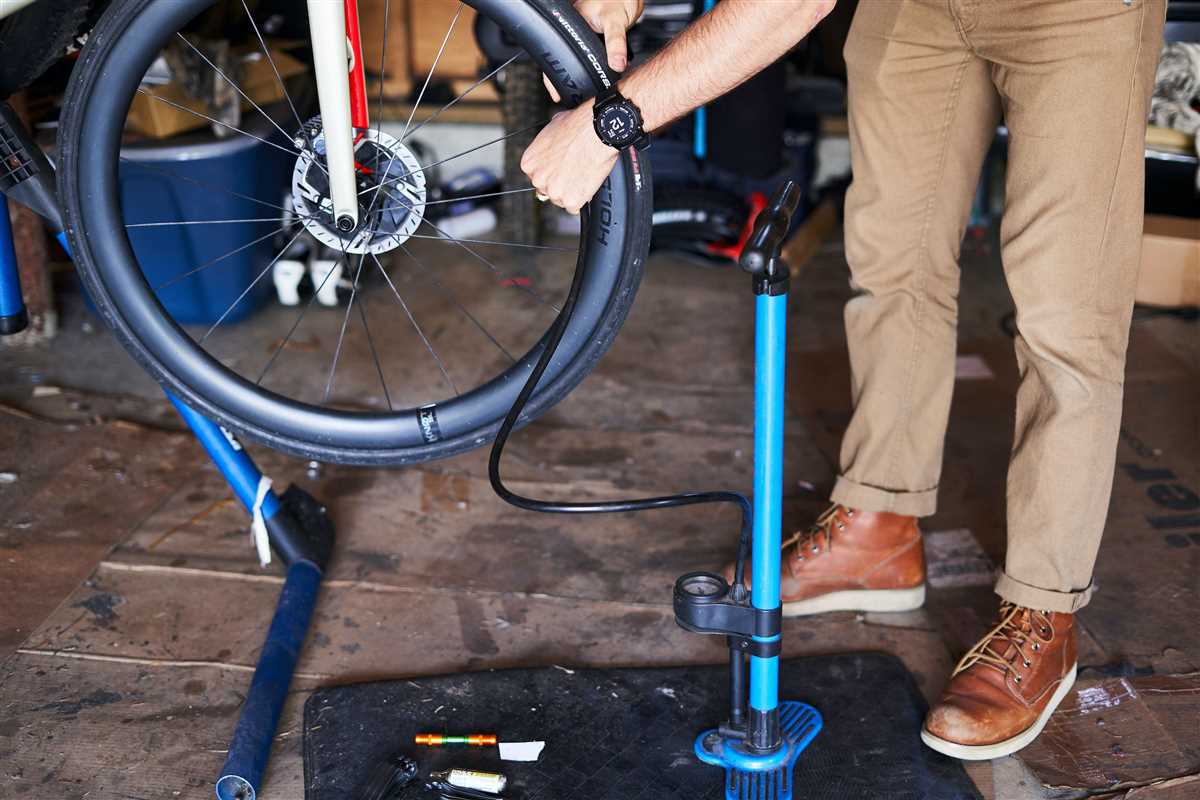
Before filling your bike tire with an air compressor, it’s important to determine the desired pressure for your tire. The pressure will depend on the type of bike you have and the surface you plan to ride on. Typically, road bike tires require higher pressures than mountain bike tires.
To determine the desired pressure, refer to the sidewall of your bike tire. It usually indicates the recommended pressure range in psi (pounds per square inch) or bar. Make sure to set the pressure within this range to ensure optimal performance and safety.
When setting the desired pressure, keep in mind that higher pressure provides a faster and smoother ride on a flat surface, but it may decrease traction on rough terrain. Lower pressure, on the other hand, offers more cushioning and better grip on uneven surfaces. Finding the right pressure for your ride will depend on your personal preference and the specific conditions of your route.
Remember to consider factors such as your weight, the weight of any cargo you may be carrying, and the weather conditions. These factors can affect the ideal pressure for your bike tire. It may require some experimentation to find the perfect balance for your needs.
“`html
Inflate the tire
After connecting the air compressor to the tire valve, it’s time to inflate the tire. Ensure that the valve is securely attached to prevent any air leaks during the inflation process.
Set the desired pressure: Before inflating the tire, check the recommended tire pressure. You can find this information on the tire sidewall or in the owner’s manual. Adjust the pressure using the air compressor’s pressure gauge or by setting the desired pressure level on the compressor.
Turn on the air compressor: Start the air compressor and wait for it to build up pressure. Most air compressors have a switch or button to turn it on. Make sure the compressor is plugged in and the power supply is working properly.
Inflate the tire: Hold the air compressor hose firmly and aim it towards the valve of the tire. Press the hose onto the valve stem, ensuring a tight seal. Once connected, turn the lever on the air compressor to release the compressed air into the tire. Monitor the pressure gauge to reach the desired pressure level.
Check the pressure: After inflating the tire, detach the air compressor hose and quickly replace the valve cap. Use a tire pressure gauge to check the tire pressure and ensure it matches the recommended pressure. If it is below the recommended level, repeat the inflation process until the desired pressure is attained.
Disconnect the air compressor: Once the tire is properly inflated, turn off the air compressor and disconnect it from the tire valve. Store the hose and the air compressor in a safe place until the next use.
“`
Test the pressure
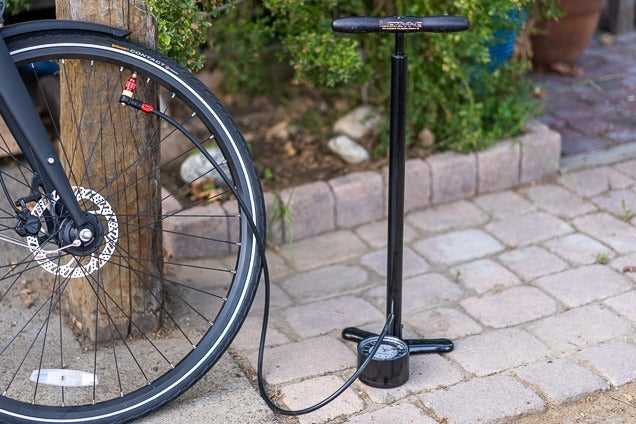
After you have connected the air compressor to your bike tire, it is important to test the pressure before filling it completely. This will ensure that you do not overinflate the tire, which can be dangerous.
Check the recommended pressure: Before testing the pressure, refer to your bike’s manual or the sidewall of the tire to find the recommended pressure range. This will give you an idea of the target pressure you should aim for.
Use a pressure gauge: Attach a pressure gauge to the valve stem of your bike tire. This will help you measure the current pressure. Simply press the gauge onto the valve stem and wait for the reading on the gauge.
Compare the reading: Once you have the reading on the pressure gauge, compare it to the recommended pressure range. If the reading is below the recommended range, you will need to add more air. If it is above the range, you may need to release some air to achieve the right pressure.
Inflate or release air accordingly: If the pressure is too low, use the air compressor to fill the tire with air in short bursts, checking the pressure periodically. If the pressure is too high, use the air compressor’s release valve to slowly release air until the desired pressure is reached.
Recheck the pressure: After adjusting the pressure, recheck it with the gauge to ensure it is within the recommended range. Continue adjusting as necessary until you reach the desired pressure.
Secure the valve: Once you have achieved the correct pressure, remove the pressure gauge and securely tighten the valve stem cap.
By properly testing the pressure of your bike tire, you can ensure a safe and smooth ride. It is important to regularly check the pressure and maintain it within the recommended range for optimal performance.
FAQ:
Why is it important to fill a bike tire with an air compressor?
It is important to fill a bike tire with an air compressor because it allows for a more efficient and effective inflation process. An air compressor can deliver a higher volume of air quickly and accurately, ensuring that the tire is properly inflated to the correct pressure. This can help enhance the overall performance and safety of the bike.
What is an air compressor?
An air compressor is a device that converts power into potential energy stored in compressed air. It is commonly used to inflate tires, power pneumatic tools, and for various industrial applications. Air compressors can be either electric or gas-powered and come in different sizes and capacities.
How do I fill a bike tire with an air compressor?
To fill a bike tire with an air compressor, you will first need to determine the recommended tire pressure for your specific bike. Once you have that information, connect the air compressor hose to the valve on the bike tire. Turn on the air compressor and slowly fill the tire with air, periodically checking the pressure using a pressure gauge. Be careful not to overinflate the tire, as this can cause damage. Once the tire is filled to the recommended pressure, disconnect the hose and securely close the valve.
What should I do if I don’t have a pressure gauge?
If you do not have a pressure gauge, it is recommended to invest in one as it is essential for maintaining the proper tire pressure. However, if you find yourself without a pressure gauge, you can estimate the tire pressure by pressing on the tire with your thumb. If it feels too soft, it likely needs more air, and if it feels too hard, it may be overinflated. It is still important to use a pressure gauge for accurate results.
Can I use an air compressor to inflate other types of tires?
Yes, an air compressor can be used to inflate other types of tires such as those on cars, motorcycles, or even inflatable toys. However, it is important to note that different tires may require different pressure levels, so it is crucial to consult the recommended pressure for each specific tire before inflating with an air compressor.
What safety precautions should I take when using an air compressor to fill a bike tire?
When using an air compressor to fill a bike tire, it is important to follow some safety precautions. First, ensure that the air compressor is in good working condition and has the appropriate pressure settings. Be sure to wear safety goggles and gloves to protect yourself from any potential debris or accidents. Additionally, always read the instructions and follow the recommended procedures for using the air compressor.
Video:











